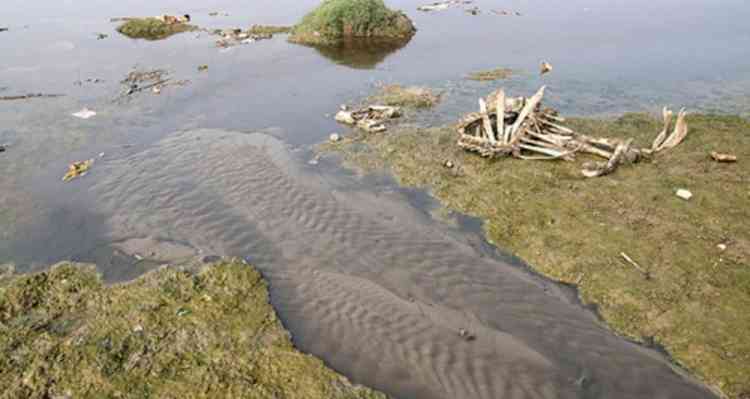Death of a river: Fish gone, farmers gone and it is the turn of residents now
"Trees were planted along the Yamuna's stretch to prevent erosion, attract birds and maintain the river's ecosystem. Now, where are the trees! Just look at the place. The shores are all gone," laments Megh Singh Rana from Kanalsi village in Haryana's Yamunanagar district.

Manoj Thakur
Yamunanagar (Haryana), July 3 (IANS/ 101Reporters) "Trees were planted along the Yamuna's stretch to prevent erosion, attract birds and maintain the river's ecosystem. Now, where are the trees! Just look at the place. The shores are all gone," laments Megh Singh Rana from Kanalsi village in Haryana's Yamunanagar district.
"Illegal mining persists, right in front of everyone's eyes. Nobody speaks up or takes action. All we can do is complain, but it falls on deaf ears," shares Ravinder Singh Chauhan, a local journalist from Chhachhrauli.
The mining mafia operates heavy machinery, which is undoubtedly illegal. Its influence is so strong that adherence to regulations is disregarded. The rules stipulate that mining should be permitted only up to three ft depth in the Yamuna. Yet, the riverbed has been excavated to a depth of 60 to 80 ft to extract coarse sand. On an average, sand worth Rs 30 lakh is plundered every single day.
The river has taken a winding route due to the presence of deep pits. This causes erosion or deposition of sediment and affects the surrounding landscape, potentially leading to flooding in areas otherwise not prone to it. "From Yamunanagar to Palwal, at least 20,000 acres get flooded every year. During this time, around 2,000 acres get washed away in the river. This affects the livelihoods of farmers in a big way," Anuj Saini, the president of Aakriti, an organisation working for environmental conservation, tells 101Reporters.
Additionally, the zigzag flow affects efficiency of water transportation, navigation and other activities that rely on a predictable and consistent flow in the river. The presence of deep pits can pose a risk to bathers, too.
Saini alleges that mining mafia employs a strategy of using small structures to impede natural flow. "Attempting to stop the flow by constructing small dams is illegal. Such interventions alter its natural course, leading to gradual drying up of the river."
Every element in the river serves a purpose. For instance, the pebbles play a crucial role in regulating the river’s flow, effectively slowing down soil erosion. When water level decreases, these stones impede the flow, creating intermittent movements and forming small waterfalls in various locations. As the water cascades down, it is enriched with oxygen from the atmosphere, thus serving aquatic beings. The fish population in oxygenated water has better health.
"Along with sand, the mining mafia extracts stones from the river, disrupting the natural system of oxygenation within the water," explains Mustkeen Mallah, the president and founder of UP Haryana Machli Kewat Mallah Ekta Samiti. Its outcome has been quite visible in the way the fish population in the Yamuna has declined. Dolphins have almost become extinct from its waters.
Until 2010, local boatmen from Mallah and Kewat communities earned their livelihood by catching fish from the river. "As difficulties mounted, they had no option but to take up cultivation of seasonal vegetables such as cucumber, muskmelon and watermelon. But even agriculture became impossible as the mining mafia started encroaching upon the lands adjacent to the Yamuna in Badoli, Madi, Takor, Baghpat, Sinauli, Bhanera, and Moonji Garhi, with the complicity of local authorities," alleges Mustkeen.
With no scope of livelihood, most of them were compelled to seek livelihood opportunities in Nepal, Bihar and Punjab. "They are away from their homes for almost 10 months a year. This has had an impact on their social wellbeing," Mustkeen adds.
Aquatic annihilation
A research conducted on the Chambal, a tributary of the Yamuna, in Etawah by a team including biologist Dr Sita Ram Tagore has highlighted the risk that sand mining poses to the river's biodiversity.
"We have observed that sand mining in Chambal region led to disruptions in migration routes, nesting patterns and egg-laying habits of gharials and turtles, forcing these species to migrate from the affected areas," explains Tagore, who is actively involved with Yamuna Jiyo Abhiyan and has extensively studied the river.
The widespread and unregulated mining practices are negatively influencing various aquatic beings such as fish, turtles, aquatic plants and microorganisms. The decreasing fauna in mining areas serve as a clear indicator of environmental disruption. "Yet, it is worth noting that no comprehensive scientific study has been conducted to fully understand the extent of the impact caused by sand mining on the Yamuna and its aquatic life."
Tagore elaborates that birds select their migration destinations based on the availability of food resources. Many choose to lay eggs on islands situated in the middle of the river. However, the disturbance caused by mining operations now compel them to seek alternative locations.
Mustkeen cites a similar case. "In Ramdha village of Uttar Pradesh's Shamli district bordering Haryana, deer could be easily spotted until 2015. We can hardly see one these days," he exclaims.
Bhim Singh Rawat, the convenor of Yamuna Jiyo Abhiyan in Yamunanagar, explains how physical structure, floodplains, biodiversity, water quality and water quantity collectively define a river’s existence. "Sadly, in this case, not a single element remains intact, indicating the river's gradual demise."
The flow of a river is governed by its natural hydrological cycle. Floodplains play a crucial role in facilitating proper dispersion of floodwaters. They serve as natural reservoirs, allowing temporary storage of floodwaters during peak periods. Once the flood subsides, these areas become highly fertile and productive for agriculture.
Environmental activist and water expert Himanshu Thakkar is worried that mining contracts are being awarded to big companies of late. "These firms have set up crushers in the middle of the river, while screening plants operate along its banks. The continuous noise generated from these activities persists day and night, and the presence of crushers contributes to an increase in airborne dust particles," Thakkar tells 101Reporters.
Wasim Ahmed (34) from Tajewala, Ramkumar Rana (55) from Tapu Kamalpur, and Ashwani Sharma (54) from Gharaunda in Karnal have repeatedly written to the state government about illegal mining, depleting water levels and declining fish population in the Yamuna. However, their pleas remain unanswered to date. "It is disheartening to witness the relentless destruction of the river in pursuit of monetary gains," they say.
Meanwhile, Minister for Mines and Geology Moolchand Sharma tells 101Reporters that regular inspections are being carried out to curb illegal mining in the Yamuna. "Immediate action is taken on complaints. The government does not rely on a single department to enforce the ban on illegal mining, but rather makes coordinated efforts," he claims.
Despite the minister's assurance on developing better strategies to deal with the issue, people living along the Yamuna are now worried that they will eventually be forced to abandon their homes and relocate if the present situation prevails.
(Manoj Thakur is a Haryana-based freelance journalist and a member of 101Reporters, a pan India network of grassroots reporters)



 IANS
IANS 








